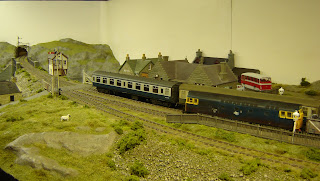Down on the seafront at Swanage there are more rails, set in the cobbles. After poking round the museum next door, and a bit of internet research, the history is quite interesting.
Back in the 18th and 19th century Purbeck stone was quarried around Swanage and used for buildings in London and elsewhere. It was carted down to Swanage and stacked on the front, before being shipped out. But Swanage does not have a harbour, so the stone was taken out to small boats at low tide using high-wheeled carts and horses bred with long legs (no, really!), then transferred to larger boats. Clearly this was rather inefficient - we are talking large blocks of stone!
So a tramway was built from the town square around the bay to a pier in deeper water, it is about 2'6" gauge but may have been of wider gauge when built. Unfortunately the connection was never made to the quarries themselves, and the locals carried on with their long-legged horses rather than pay the fee for the tramway and pier! A few years later the standard gauge railway arrived, and the stone went out by rail, so the stacking yards on the seafront were replaced with houses and shops. The tramway was used to transport fish in later years, but so far as I can see only ever used horse power.

The line starts with two sidings (one visible to the left, the other along the building) just off the Square. I think this building was a fish store, and at the far end a siding clearly ran into it (that end is now an amusement arcade, the nearer bare brick end is the museum). The route of the tramway can just be made out on google maps here - running East around the shoreline to the harbour and pier, not the current pleasure pier but the aerial photos show the supports of the original stone loading pier. There are more photos of the tramway route here - helpfully the rain means less people in the way! More information can be found here and here.
Now that wouldn't make a very interesting model! But what if it had been connected to a quarry? And what if it had been connected to the standard gauge station when the railway came to town? After all, it would have only needed to run a little further along the front, cross a stream, then run up Station Road .... Stone was quarried from the cliffs around the coast and brought in small boats to Swanage, so the line could then have been used to bring it from the pier to the railway, as well as fish, coal (to the steam ships), rubble for sea defences, perhaps even passengers from the station to the pleasure pier and steamers.
So with a little "modellers licence" there is potential for an interesting layout. It might be rather long and thin, I imagine it could be built in a number of scenes. The pier(s) (including steamer pier, and some boats if you like), quayside with fishing boats, then the town front with the sea in the foreground and the fish shed as a backdrop, finally the line turning up the street towards the station. Even so it would be a short line, so small loco's and in later years internal combustion loco's would provide the motive power (in reality horses would do, but they are more tricky to model!).























